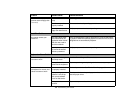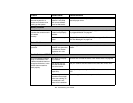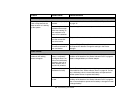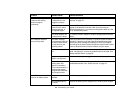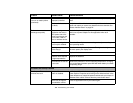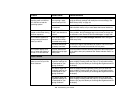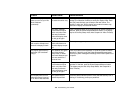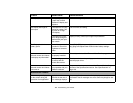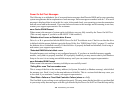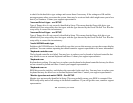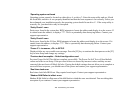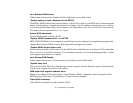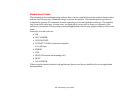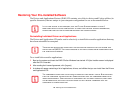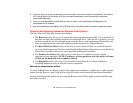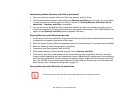
108
- Troubleshooting Your LifeBook
Power On Self Test Messages
The following is an alphabetic list of error-and-status messages that Phoenix BIOS and/or your operating
system can generate and an explanation of each message. Error messages are marked with an *. If an error
message is displayed that is not in this list, write it down and check your operating system documentation
both on screen and in the manual. If you can find no reference to the message and its meaning is not clear,
contact your support representative for assistance.
nnnn Cache SRAM Passed
Where nnnn is the amount of system cache in kilobytes success-fully tested by the Power On Self Test.
(This can only appear if you have an SRAM PC Card installed.)
*Diskette drive A error or Diskette drive B error
Drive A: or B: is present but fails the BIOS Power On Self Test diskette tests. Check to see that the drive
is defined with the proper diskette type in the Setup Utility, See “BIOS Setup Utility” on page 53. and that
the diskette drive is installed correctly. If the disk drive is properly defined and installed, avoid using it
and contact your support representative.
*Extended RAM Failed at offset: nnnn
Extended memory not working or not configured properly. If you have an installed memory upgrade
module, verify that it is properly installed. If it is properly installed, you may want to check your Windows
Setup to be sure it is not using unavailable memory until you can contact a support representative.
nnnn Extended RAM Passed
Where nnnn is the amount of memory in kilobytes successfully tested.
*Failing Bits: nnnn The hex number nnnn
This is a map of the bits at the memory address (in System, Extended, or Shadow memory) which failed
the memory test. Each 1 (one) in the map indicates a failed bit. This is a serious fault that may cause you
to lose data if you continue. Contact your support representative.
*Fixed Disk x Failure or Fixed Disk Controller Failure (where x = 1-4)
The fixed disk is not working or not configured properly. This may mean that the hard drive type identified
in your setup utility does not agree with the type detected by the Power On Self Test. Run the setup utility



